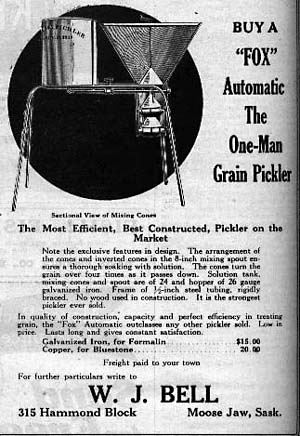Search | Image Archive | Reference | Communities | POV | Lesson Plans | Credits
 In addition to the need to develop new methods of tillage and water conservation, farmers at the turn of the century faced the problem of controlling crop-destroying diseases. The most damaging such disease, smut, was largely overcome by the end of the first decade of the century.
In addition to the need to develop new methods of tillage and water conservation, farmers at the turn of the century faced the problem of controlling crop-destroying diseases. The most damaging such disease, smut, was largely overcome by the end of the first decade of the century.
Smut is a fungal infection to which the hard wheats that are the first choice of prairie farmers were especially vulnerable. A smut infection shows as a dirty black powder which fills the kernels of the wheat, in some instances replacing the entire grain. The common varieties of smut have a powerful taste and odour, and infected grains are unfit for human consumption.
In the 1890s. it was discovered that soaking seed wheat in a solution of copper sulphate, or bluestone, killed smut spores without damaging the seed. In a process called bluestoning, sacks of seed were immersed in a copper sulphate solution overnight, after which they were treated with lime and laid out to dry.
As time passed, more effective techniques of bluestoning were developed which permitted farmers to treat larger volumes of seed in a more effective manner. By 1910, most farmers owned a "grain pickler" a hand-cranked device that ensured the rapid, but thorough wetting of the seed grain with the copper sulphate, and most commercial seed was so treated. In this way, the incidence of this crop destroying disease was significantly reduced, and prairie farming became a markedly more secure enterprise.
Page revised: 29 August 2009